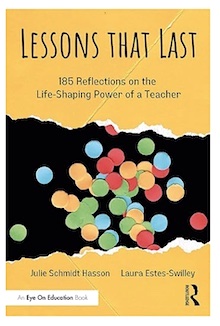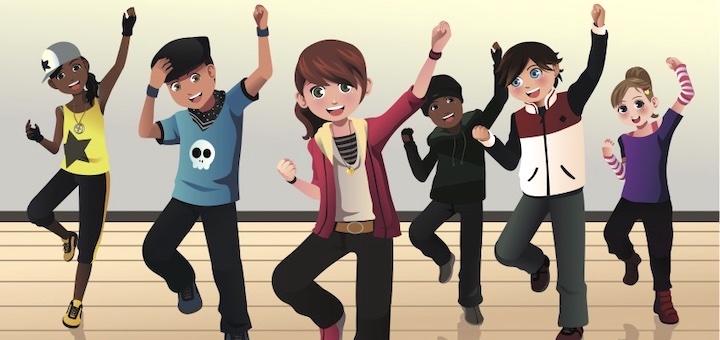What Makes Some Teachers So Memorable?
By Julie Schmidt Hasson
 Everyone remembers a favorite teacher, but why? What makes some teachers so memorable?
Everyone remembers a favorite teacher, but why? What makes some teachers so memorable?
I’ve spent years interviewing people about their memorable teachers, trying to answer those questions. The stories participants shared are inspirational, highlighting the ways a teacher’s actions and interactions in the classroom can make a lasting impact on a student’s life. The stories are also informational, providing models to help teachers make a more consistent impact.
In some classrooms the student-teacher relationship seemed mostly transactional. The teacher assigned the work, the student did the work, the teacher graded the work. Those classrooms are a bit fuzzy in people’s memories, if remembered at all.
The clear memories came from classrooms where a student and teacher related as humans. There was a connection and genuine engagement in teaching and learning. Strong connections are the crux of memorable school experiences.
The teachers in the stories people shared with me are often described as authentic, encouraging, and playful. These attributes contribute to a positive and inclusive learning environment, particularly in the middle grades.
When teachers create a space where students feel accepted, valued, and supported, anxiety is lessened, allowing for greater cognitive and emotional engagement. A positive classroom atmosphere encourages collaboration, creativity, and critical thinking. These are the kinds of classrooms where lasting memories are formed. To illustrate, let’s look at three of the stories in my collection.
Cedrick’s Story
When you bring your authentic self to class each day, you create a safe space for your students to be themselves. This story comes from Cedrick, who remembers the happy environment in Mr. Colson’s classroom.
“Middle school was a challenging time for me. I remember trying hard to fit in but always feeling out of place. It felt like I had to constantly censor what I said and what I did for fear other kids would make fun of me. I had always been a silly, fun-loving kid, but I didn’t feel free to be me in middle school.

“The thing I loved most about Mr. Colson was his propensity for dad jokes. For some reason, I remember all of them. Why do melons have big weddings? Because they cantaloupe. And, What happened when the cheese factory exploded? Da brie was everywhere. Mostly I enjoyed seeing the cool kids try not to laugh.
“Mr. Colson was so comfortable being silly and being himself that we all felt like we could relax a little. His classroom was the one place I felt safe to be me. I remember it as a happy place, a welcome respite during a challenging time. I’ll remember Mr. Colson as the one who showed me it’s hip to be square.”
Like Mr. Colson, when you show up in the classroom authentically, you give your students permission to do the same. Authentic teachers serve as role models for students. By being true to yourself, you demonstrate honesty, integrity, and self-awareness, qualities students can emulate in their own lives. Authenticity also fosters trust between teachers and students. When you are genuine and sincere, students feel more comfortable sharing ideas, asking questions, and seeking help.
Authenticity in teaching can make lessons more engaging and meaningful, too. By incorporating your passions, interests, and personality into your teaching, you can better capture students’ attention and inspire them to learn. Authentic teachers celebrate the uniqueness of each member of the classroom community.
Middle school is the time when students are exploring their own identities. By embracing your authenticity, you create a supportive environment where students feel empowered to express themselves more freely. Authenticity is a big reason memories of Mr. Colson’s classroom continue to stick with Cedrick.
Wayan’s Story
Every teacher has an individual style, a persona. Your persona helps students know what to expect from you, and a persona characterized by positivity and encouragement is memorable. This story comes from Wayan, who remembers Mr. Kerner’s encouraging words.
“Mr. Kerner was my sixth-grade language arts teacher. I remember him as a positive and encouraging presence during my challenging middle school years. He always found something to compliment, and he was quick with a pat on the back.

“I saved a bunch of my notes from him in a box of school memorabilia, and they remind me of the importance of words of affirmation. I try to leave the same kind of encouraging notes for family, friends, and colleagues. In the realm of influencing young lives, Mr. Kerner definitely rocked.”
As Mr. Kerner demonstrated, positive feedback and encouragement from you can boost your students’ self-esteem and confidence. When students feel supported and validated by their teachers, they are more likely to believe in their abilities and take on challenges with a positive attitude.
Encouraging words can also serve as powerful motivators for students. When you acknowledge students’ efforts and progress, you reinforce the idea that hard work pays off, and you inspire students to continue putting in effort towards their goals. A classroom atmosphere filled with encouragement and positivity is conducive to learning because students are more likely to engage in class activities, participate in discussions, and take academic risks when they feel supported.
Your encouragement helps students develop resilience by teaching them to persevere through challenges and setbacks, too. When you acknowledge students’ efforts and provide constructive feedback, you demonstrate that mistakes are a natural part of the learning process and not something to be feared. Because of the importance of positivity and encouragement, Mr. Kerner’s words stuck with Wayan and helped him keep rocking, even when facing life’s challenges.
Lance’s Story
In addition to authenticity and encouragement, incorporating playfulness into the classroom can lead to a more dynamic and effective learning experience for students. This story comes from Lance, who remembers a playful project in Miss Salter’s class.
“My middle school social studies teacher, Miss Salter, was full of energy and ideas. I loved just being around her. One day in early October, she shared an idea with our class. We would secretly learn the dance from Michael Jackson’s Thriller video and perform it as a surprise number at the pep rally. I wasn’t so sure about dancing, but nobody could say no to Miss Salter.
“We spent the last fifteen minutes of every class pulling down the blinds and learning the dance. We didn’t tell anyone about our plan. On the day of the pep rally, we were seated randomly throughout the bleachers. When the music started, we got up one by one and moved like Zombies onto the gym floor.
“I’ll never forget the cheering of the crowd as we got into our line and performed the dance. It was so much fun, and everyone loved it. It also bonded us as a class, as we became known as the Thriller class. Every October, when that song is played at a Halloween party, I still find myself dancing and remembering Miss Salter.”
Like Miss Salter, when you bring playfulness to your teaching, you make learning more engaging and enjoyable for students. When your lessons incorporate elements of play, students are more likely to be actively involved in the learning process and retain information better. Playfulness also encourages creativity and imagination. It allows students to explore new ideas and concepts in a less structured environment, facilitating innovative thinking and better problem-solving skills.
Playfulness can also help reduce stress and anxiety in the classroom. When your students feel relaxed and comfortable, they are more open to learning and can better focus on the task at hand. Positive relationships flourish in play because it creates a sense of camaraderie and mutual respect, which can lead to a more supportive and inclusive learning environment.
Through play, you can enhance learning by providing opportunities for hands-on experiences and experimentation. When your students actively engage in play, they are more likely to understand complex concepts and develop a deeper understanding of the material. That playful experience in Miss Salter’s class continues to be a vivid memory for Lance.
Keys to Being Memorable
In a world where young people are encouraged to fit in, to be guarded, to conform to norms, you can encourage your students to stand out. You can create an inclusive environment where middle school students engage more fully through authenticity, encouragement, and playfulness. That’s a lesson that lasts.
T-shirt image: Zazzle

Julie’s research on long-term teacher impact is the foundation of her books, professional development programs, and TEDx Talk. Her book, Safe, Seen, and Stretched in the Classroom: The Remarkable Ways Teachers Shape Students’ Lives, was published in 2022. Her book Pause, Ponder, and Persist in the Classroom: How Teachers Turn Challenges into Opportunities for Impact, was released in June 2023. Julie is also the co-host of the Lessons That Last podcast.






























